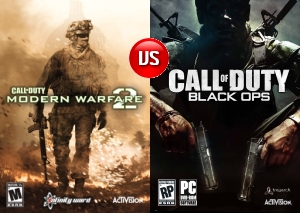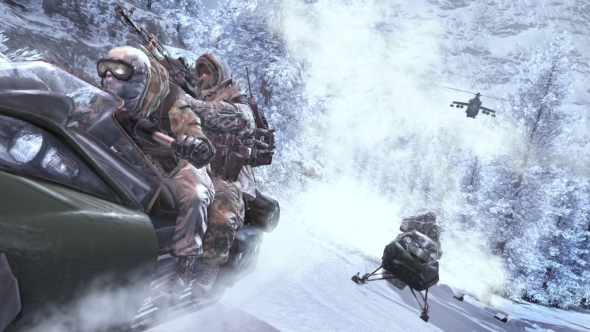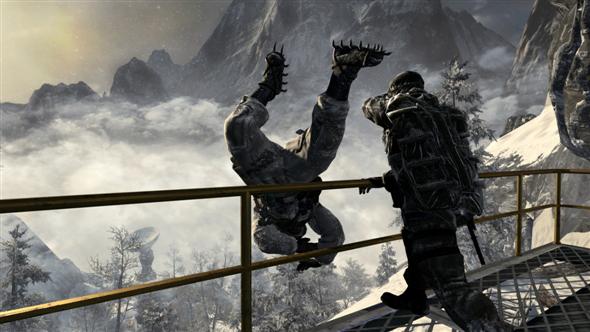 When Infinity Ward released Call of Duty: Modern Warfare 2 in 2009, it launched one of the biggest names in gaming into the stratosphere of pop culture. A year later, at the time it needed to deliver most, Treyarch released Call of Duty: Black Ops, which not only matched the records of Modern Warfare 2, but shattered them. This prolific series fought its way to the top of the charts while spurning out ugly legal battles and one of the most caustic rivalries in the history of gaming. Now that the first map pack for Black Ops is about to be available on all platforms, it’s time to examine the comparative merits of these two games, and this is our focus for the second installment of The G-Spot.
When Infinity Ward released Call of Duty: Modern Warfare 2 in 2009, it launched one of the biggest names in gaming into the stratosphere of pop culture. A year later, at the time it needed to deliver most, Treyarch released Call of Duty: Black Ops, which not only matched the records of Modern Warfare 2, but shattered them. This prolific series fought its way to the top of the charts while spurning out ugly legal battles and one of the most caustic rivalries in the history of gaming. Now that the first map pack for Black Ops is about to be available on all platforms, it’s time to examine the comparative merits of these two games, and this is our focus for the second installment of The G-Spot.
On March 25, 2009, Infinity Ward President and Game Director Jason West received the text message “treyarch released their mp dlc video,” referencing the trailer for the first DLC map pack for Call of Duty: World At War. West responded to his employee “we release our video? Crush and destroy with our video,” to which the employee responded “we already did. And… we already did.” This episode is characteristic of the competition between Call of Duty’s two main studios, constantly trying to outdo each other year after year. Compared to Infinity Ward, the founders of the franchise, Treyarch was indeed pigeon-holed as the red-headed step child by many game journalists. Stuck in the World War II sub-genre, Treyarch’s games just weren’t as edgy as the modern military shooters Infinity Ward moved on to. However, with the release of Black Ops, the younger studio got the chance to implement all the sexy killstreaks and weapon attachments the Modern Warfare games were known for. Despite concerns of oversaturation, reviewers were pleased with Black Ops, finding that Treyarch was no longer playing catch-up with Infinity Ward. Did Treyarch outdo their counterpart, or did Infinity Ward’s magic reinforce the superior quality that earned them their reputation?
When it comes to story, you can’t really hold either game in high regard. The Call of Duty campaign format has been criticized for repetitive gameplay in linear levels, interspersed with shock and awe set pieces that are always style over substance. Much of the exposition occurs on the loading screens, which are mostly mission briefings spiced up with stock military catch phrases. You could argue the AC-130 mission in the first Modern Warfare displayed the detached, impersonal nature of killing on the contemporary battlefield, or that the SR-71 opening of “WMD” in Black Ops represents the terrifying sophistication of classified technology during the Cold War, but you’re really reaching at that point. There’s no upfront social commentary on war like in Metal Gear Solid, or sincere character development like Uncharted. Instead, you’re given the best thrill ride your money can buy.

Call of Duty: Modern Warfare 2
In that respect, Modern Warfare 2 succeeds over Black Ops, despite being about half as long. Bursting off Glock rounds from a snowmobile clearing a chasm in northern Russia, running unarmed from a “Hornet’s Nest” of militia in South America, or carving your way through two clashing paramilitary forces in Afghanistan and ultimately driving a jeep up the ramp of a gunship as it’s taking off are some of the most intense moments of this generation, and show how Infinity Ward can pull off moments other studios wish they could. That’s not to say Treyarch didn’t come close. Escaping from the Russian gulag in Vorkuta is probably the closest the series has ever come to the jaw-dropping Stalingrad opening of the Soviet campaign in the first game. But the aforementioned SR-71 sequence is the only other big moment that breaks up the monotony, and the campaign’s helicopter mission was done better in the reboot of Medal of Honor.
But it would be superficial to judge a single player experience by the number of set pieces. When it comes to a story, Modern Warfare 2 simply doesn’t have one. The conflict with the main villain who commits a horrifying atrocity early on is never resolved; the “twist” real villain comes in at the eleventh hour with hardly any motive at all; and while some may claim they’re meant to be left open-ended, you’re never given a meaningful reason as to why you’re taking on some of your bigger objectives. Black Ops was different. The game was about unquestioning loyalty in an era of uncertainty, “a sense of duty when the risks run high.” Many of the characters had personal reasons for going after the antagonists and you see a substantial bond between them, such as when rescuing the Soviet defector Weaver or the Russian roulette scene. While the game has many obvious targets for critique, at the very least it has a beginning, middle, and an end, with a defined villain throughout the story, the conflict with whom is actually resolved by the end of the game.
While gamers’ tastes may differ over whether they prefer big Hollywood action moments or a coherent plot, Black Ops has just enough set pieces for me to call it as the better campaign for having a meatier story, or at least a story with some meat on its bones.
However, it’s not the campaign that made the Call of Duty series the industry colossus it is today. What most gamers spend their time on, and what these games will be remembered for, is their multiplayer. Both games have simple and quick matchmaking, a considerably large map count at launch, and potentially the most customizable loadout-based system in the history of First-Person Shooters.
Unfortunately, with such a high level of variety comes a nightmare of balancing them all conjunctively to work in a single game. I sometimes refer to Modern Warfare 2 as an experiment in how much variety you can cram in a single package without it collapsing upon itself. After more than two years, and a slew of patches, I would posit that the experiment has failed. While the game has a high count of weapons, attachments, and perks, there are many that can each be easily exploited to decimate players using other equipment and abilities. The Commando perk allows players to literally teleport impossible distances with knife attacks and the grenade launcher requires little to no effort at all. You could argue that a losing player could make the same loadouts to counter these exploits, but forcing yourself to play cheap because others are doing so does not make for a good game. Furthermore, it already takes very few bullets to snag a kill in Modern Warfare 2; the extra bullet damage with the Stopping Power perk and overpowered guns like the SCAR-H or UMP45 make aiming and controlling your fire a skill-less endeavor. When you add in the fact that every map is filled to the brim with too many hiding spots to check at once, the game is like a massive Boy Scout reservation, begging you to set up a tent and wait to rack up the kills while Craig Fairbrass gives you a false sense of accomplishment, telling you your Harrier jets are standing by. In other words, the game is a campfest.
That’s not to say it isn’t good. It carries over the flashiness of the campaign with a greater visual fidelity than Black Ops (despite being a year older) and the map design may be more interesting and better thought out. And while it’s easier to fall back on the easily exploitable perks and equipment, it’s still rewarding when you find a sweet combination, like using the Scavenger perk to have ever-replenishable smoke grenades, and using an Infra-red scope to shoot your oblivious enemies through the smog. Still, you’ll probably have to return to overpowered guns like the UMP to make it work, and plant the overpowered Claymores to cover your back.

Call of Duty: Black Ops
Within months a very vocal segment of the gaming community made these issues known, and Treyarch seems to have listened to each one of them as Black Ops took the complete opposite approach with its multiplayer. While claiming an even larger amount of equipment to choose from, everything seems to have been collectively watered down so that none of it really emerges as being obviously exploitable. They even packed in some really quirky stuff like the ballistic knife and the returning flamethrower to make you want to get those interesting game-winning killcams so everyone in the lobby can marvel at what an unorthodox player you are. The Contracts challenges to perform certain feats within a designated time span also encourage you to go out and get kills instead of wait and let them come to you. Finally, the near-superfluous amount of submachine guns in the game is like a subtle message from Treyarch saying “this is a ‘run and gun’ game. Play it, and have fun with your friends.”
The real test for me was when I went back to Modern Warfare 2 while I waited for Senior Editor Nicole Kline to prestige in Black Ops. I was almost seduced by the shinier environments, better looking weapons, and more realistic character models. But when I came back to Black Ops, it was immediately apparent which game was more fun. The guns may not look and feel as good, the maps and characters may be more cartoony, but at least I know I’m guaranteed an even playing field every time with Treyarch. Without going into too much detail about co-op, I think the tight missions in MW2’s Spec Ops and the sprawling maps in Black Ops’ Zombies carry over the recurring theme of “different strokes for different folks.” But still, I can’t help but think there’s a reason Zombies has enjoyed a kind of cult status among gamers while Spec Ops hasn’t.
Before its release this week, I was eagerly awaiting Killzone 3. I still consider its prequel the best FPS this generation and hope to lose myself in my favorite multiplayer format for quite some time. As good as KZ3 could be, I can’t lie to myself. I’m going to inevitably return to Call of Duty for some accessible matchmaking, loadouts instead of classes, and map and equipment variety that makes the series as popular as it is.
And when I do, it’ll be for some Black Operations.
– G
Mike Gutierrez considers himself a very good writer at Warp Zoned. He wrote this entire feature without once using the abbreviation CoDBlOps… Dammit!







